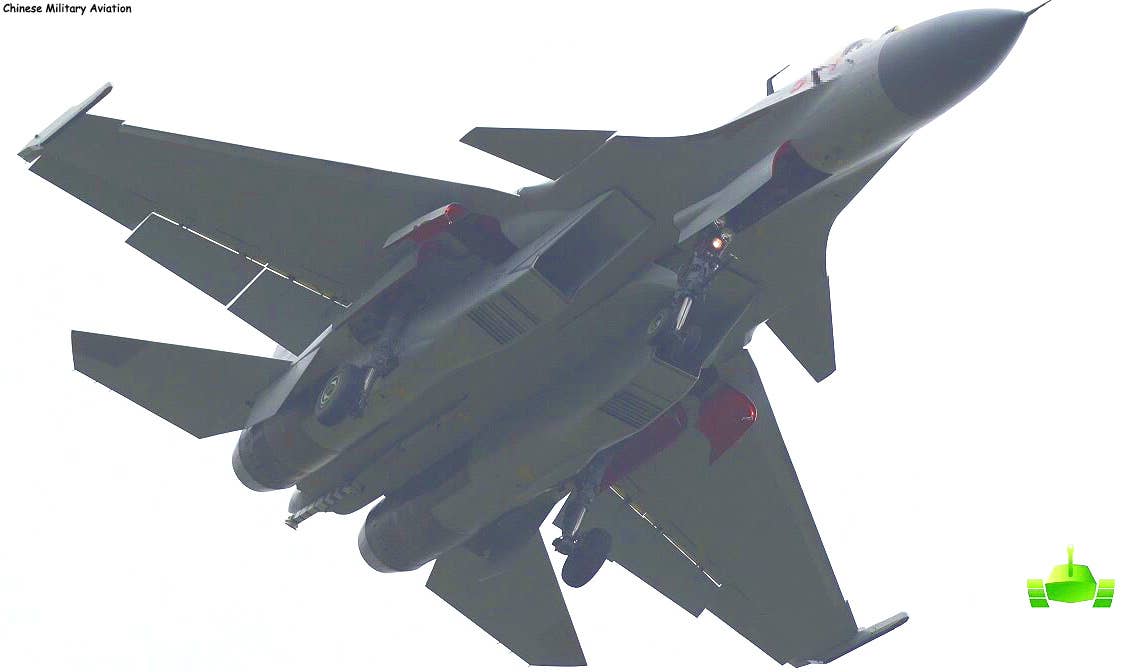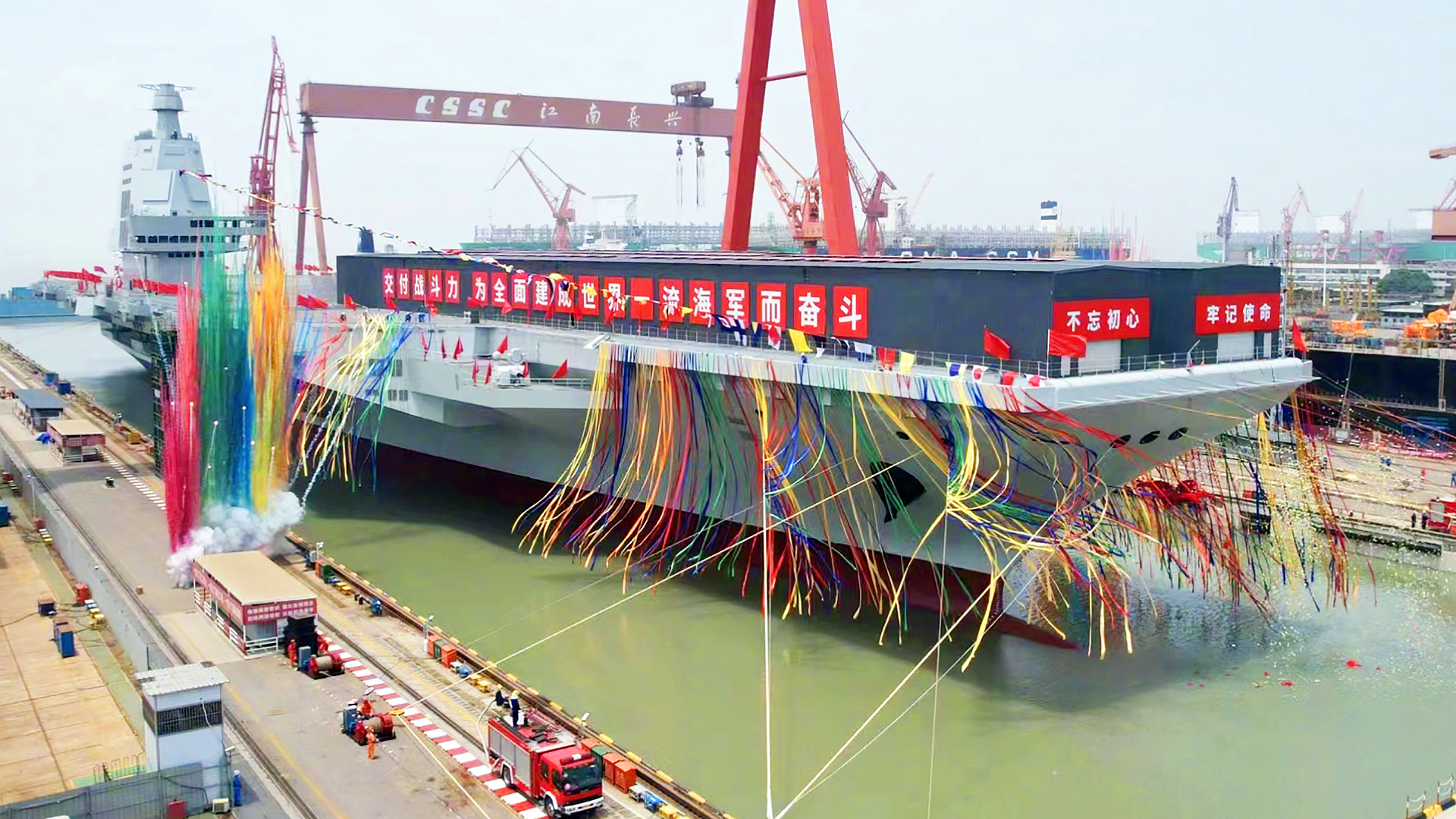After much build-up, China has launched its latest aircraft carrier, the country’s third, during a ceremony at Shanghai’s Jiangnan Shipyard today, June 17. The event marks the next major advance for the Chinese shipbuilding industry, as the country aims to field a home-grown carrier fleet that will only be eclipsed by the U.S. Navy.
The carrier, previously known only as the Type 003, but now formally named Fujian, after the southeastern Chinese province, is the most advanced yet for the People’s Liberation Army Navy (PLAN). It is expected to herald the introduction of a new and more capable air wing, alongside other improvements.
By June 14 at the latest, there were clear signs that China was preparing to launch the new carrier, with satellite imagery revealing that the warship’s dry dock had been flooded. At the same time, the carrier had received prominent decorations along its three catapult tracks, as well as flags draped over the island and down its side, and along the perimeter of the flight deck. By June 16, a large podium had been set up alongside the dock, for the official launch ceremony.
While the new carrier has now been launched, the final phases of its construction are still underway and it’s unclear when it will be ready to start sea trials, which are a prerequisite ahead of full entry into service.
The Type 003 was first noted under construction at Jiangnan Shipyard in mid-2017. Since then, there has been much speculation about the carrier and, in particular, how it would differ from the two that are already in PLAN service.
The first of these, the Type 001 Liaoning, was acquired from Ukraine as an incomplete Soviet Kuznetsov class ship, the Varyag. The next to enter service, the Type 002 Shandong, was built in China but modeled after the Type 001.
A useful comparison showing the development of the successive Chinese carriers:
As seen in the image above, and in more detail in those below, the island superstructure on the Type 003 is more compact and neater than in the previous two carriers. The uncluttered island also features prominent flush apertures for electronically scanned array radar antennas and there will likely be other antennas added in the future, along with additional mission components.
Unlike the U.S. Navy’s supercarriers, the Type 003 uses conventional rather than nuclear propulsion and features three catapults instead of four.
Significantly, both the Type 001 and 002 are equipped for short takeoff but arrested recovery, or STOBAR, operations. This involves launching fixed-wing aircraft with the aid of a ‘ski-jump’ ramp on the bow and then recovering them using arrester wires.
The Type 003, however, has no bow ramp and instead marks the PLAN’s switch to catapult-assisted takeoff but arrested recovery, or CATOBAR, operations. While recovery is the same, CATOBAR carriers employ catapults to launch fixed-wing aircraft, allowing them to take off with much heavier fuel and weapons loads. In addition, CATOBAR vessels can support a wider range of aircraft types, including heavier and slower non-fighter designs like the KJ-600 carrier radar plane now in development. Currently, only the United States and France operate carriers of this kind.
Not only will the new carrier introduce the CATOBAR concept to the Chinese, but the PLAN is also expected to leapfrog the traditional steam-powered catapults and instead use an electromagnetic aircraft launch system (EMALS) on its Type 003.
As we have discussed previously, EMALS offers a range of advantages, most notably increased sortie-generation rates and less outsized mechanical demands on the vessel’s design. On the other hand, EMALS technology is difficult to master. So far, only the U.S. Navy’s Ford class has been fitted with this kind of equipment and its introduction has not gone entirely smoothly. On the other hand, once perfected, EMALS is set to set to bring additional benefits. EMALS also promises to reduce the strains imparted on the aircraft themselves, by offering the ability to more closely tailor the forces generated on launch, depending on the aircraft type. This latter point is especially relevant for launching drones of all sizes from carriers, an area in which China is clearly already interested.
In terms of manned aircraft, the Type 003 should also mark a major advance over the previous two PLAN carriers. While these vessels have gone to sea operating first-generation J-15 Flanker fighter jets, which have revealed several limitations, plus helicopters, the new warship is almost certain to field new types like the carrier version of the FC-31/J-35 stealth fighter jet together with more capable, CATOBAR-optimized versions of the J-15. The latter should include a multirole version of the single-seat Flanker as well as the two-seat J-15D electronic warfare jet. Adding the KJ-600 and potentially new rotary-wing types, followed by drones, will complete a major overhaul of the PLAN carrier air wing.


As to how the new carrier will be used once in operational service, it seems certain that it will sit as the centerpiece of the PLAN and will be paired with a powerful strike group, which will be similarly used to project power over long distances as part of China’s fast-developing bluewater capabilities. As well as increasing the scope for Beijing to launch all manner of military operations further from its own borders, the vessel should become an important symbol of Chinese naval prowess.
Clearly, the potential of such a carrier, together with an advanced air wing, in contingencies relating to Taiwan is prominent in many people’s thinking, although the Type 003 is arguably just as valuable as a means to generating airpower further afield, starting with the strategically vital and hotly contested South China Sea. The Type 003 and its battle group could also range much further than that, too, expanding the PLAN’s footprint in emerging areas of interest such as the Horn of Africa and beyond.
In the meantime, despite leaving the dry dock today, the Fujian is still at least several years away from full operational service, and much work will still be needed to refine the CATOBAR concept of operations as well as new elements of the air wing. However, the launch of this impressive new warship today continues the PLAN’s long march toward becoming not only one of the biggest but also among the most capable navies in the world.
UPDATE: 10:40 AM EST —
New details about the PLAN’s official plans for the newly launched Fujian, which has also been assigned the hull number CV-18, have now emerged. The carrier, which is expected to have a fully-loaded displacement of 80,000 tons when it enters service, is now set to undergo mooring and sea trials ahead of its official commissioning, according to China Military, the PLA’s official English-language news outlet.
“The Navy will choose the deployment location of the Fujian based on the need to safeguard national sovereignty, security and development interests, as well as the characteristics of carrier operations and logistics support conditions of the port,” Global Times, an English language newspaper published under the auspices of the Chinese Communist Party, reported, citing Senior Captain Liu Wensheng, a PLAN spokesperson.
“According to regulations governing the naming of PLA Navy vessels, aircraft carriers are usually named after provincial administrative units, and that is why the third aircraft carrier is named after East China’s Fujian Province,” Liu also said according to Global Times. This statement would seem to downplay any potential links between the carrier’s name and the fact that Fujian is the closest province in mainland China to the island of Taiwan. Liaoning and Shandong are also named after provinces in China.
It has also been pointed out that covers over Fujian’s catapults during the launch had been covered in patriot slogans, translations of which have now appeared on social media. They reportedly include:
- To achieve the goal of military construction of CPC [Communist Party of China] in a new era, make the PLA a world-class force.
- Strive to build a strong modern navy, to be the strong backup of China’s dream.
- To build a world-class shipwright corporation, with core position of military industry, reasonable industrial structure, leading quality benefits and strong international competitiveness.
Contact the author: thomas@thedrive.com
